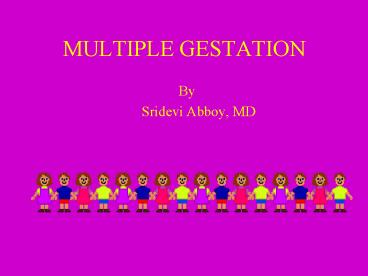MULTIPLE GESTATION - PowerPoint PPT Presentation
1 / 27
Title:
MULTIPLE GESTATION
Description:
MULTIPLE GESTATION By Sridevi Abboy, MD Definition (Multi-fetal Gestation) MULTIPLE PARITY -Twins (two babies) -Monozygotic(Division of 1 ova fertilized by the same ... – PowerPoint PPT presentation
Number of Views:205
Avg rating:3.0/5.0
Title: MULTIPLE GESTATION
1
MULTIPLE GESTATION
- By
- Sridevi Abboy, MD
2
Definition(Multi-fetal Gestation)
- MULTIPLE PARITY
- -Twins (two babies)
- -Monozygotic(Division of 1 ova fertilized by
the same sperm) - -Dizygotic(Fertilization of 2 ova by 2 sperm)
- -Triplets (three babies)
- -Quadruplets (four babies)
3
Incidence
- Twins - 1 in 100 births
- African Americans 1 in 70
- Caucasians 1 in 88
- Japanese 1 in 150
- Chinese 1 in 300
- Triplets are about 1 in 7,500 births
- Quadruplets are about 1 in 650,00 births
4
Predisposing Factors
- Maternal age and parity
- Maternal height and weight
- Genetic and racial factors
- Prior use of oral contraceptive agents
- Social class
- Seasonality
5
Causes of Multiple Gestation
- Spontaneously
- In Vitro fertilization
- Intrauterine insemination
- Assisted Hatching
- GIFT, ZIFT
- Frozen Embryo Transfer, Blastocyte Embryo
Transfer - Fertility Drugs
- Clomiphene citrate (clomid, serrophene)
- Gonadotropins (GonalF, follistim, humagon)
6
Twins
- Dizygotic twins
- (66 of US twins)
- Dichorionic separate chorion (placenta)
- Diamniotic separate amnion (amniotic sac)
- Monozygotic twin (33 of US twins)
- Ova division
- lt 72 hours Dichorionic, diamniotic
- 4-8 days Monchorionic, diamniotic
- 8-13 days Monochorionic, monoamniotic
- gt 13 days conjoined twins
7
Conjoined Twins
- Craniopagus
- Pygopagus
- Thoracopagus
- Cephalopagus
- Epholothoracopagus
- Parapagus
- Ischopagus
- Omphalopagus
- Parasitic twins
- Fetus in fetu
8
Conjoined Twins(paraphagus)
http//www.conjoined-twins.i-p.com
9
Multiple Birth Stats (2000)
- Number of live multiple births in 2000 119,648
- Number of twin births 118,916
- Number of triplet births 6,742
- Number of quad births 506
- Number of quintuplets and higher birth 77
-
http//www.cdc.gov/nchs/fastats/multiple.htm
10
Cost per infant
- Infants born 39-42 weeks 9,803
- Infants born 25-27 weeks 280,146
- Twins born 25-27 weeks 560,292
- Triplets born 25-27 weeks 840,438
- Quads born 25-27 weeks 1,120,584
- http//www.multiplebirth.com/New_Folder/Articles/
MultgestEpidemCauseConsequesnces.doc
11
Days in NICU
- GA 23-25 weeks 100-125
- GA 25-27 weeks 80-100
- GA 28-29 weeks (quads) 55-75
- GA 30-31 weeks 25-45
- GA 32-33 weeks (triplets) 15-35
- GA 34-35 weeks (twins) 10-25
- GA 36-40 weeks 1-10
http//www.metrohealth.org/clinical/NIC
U/2000.htm
12
Average age of gestation
- Number of babies Weeks of Gestation
- 1 40 weeks
- 2 35 1/2 weeks
- 3 33 weeks
- 4 29 ½ weeks http//www.bestdoctors.com/
en/conditions/g/gestation/gestation_100200.htm
13
Handicap Rates (per 1000 post-natal survivors)
- Overall Severe Moderate
- Singletons 90.6 19.8 70.8
- Twins 125.6 33.7 92.0
- Triplets 178.1 57.1 121.0
- http//www.multiplebirth.com/New_Fo
lder/Articles/MultgestEpidemCauseConsequesnces.doc
14
Cerebral Palsy
- Singleton Twin Triplet
- standardized standardized
standardized - Per 1000 live births 1 4.6 16.6
- Per 1000 1st year
- survivors 1 4.6 17.4
- Per 1000 pregnancies 1 8.3 47
http//www.multiplebirth.com/New_Fo
lder/Articles/MultgestEpidemCauseConsequesnces.doc
15
Mortality Rates(per 1000 live births)
- Infant Neonatal Postnatal
- (birth to 1 year) (birth to day 28)
(day 29 to 1 year) - Singletons 11.2 7.8 3.4
- Twins 66.4 55.9 10.5
- Triplets 190.4 168.8 21.6
- calculated from the
vital statistics of the US, 1998 - http//www.multiplebirth.com/New_Folder/Articles/
MultgestEpidemCauseConsequesnces.doc
16
Mean birth weight
- Singletons Twins Triplets
- Mean BW(gm) 3357 2389 1735
- lt1500gm 1.1 10.12
31.88 - lt2500 gm 6.06 52.24 91.52
- SGA 9.38 35.63 36.57
http//www.multiplebirth.com/New_Folder/Articles/M
ultgestEpidemCauseConsequesnces.doc
17
Peripartum Complications
- Prematurity-major cause of neonatal death
- 50 of twins
- 90 of triplets and higher
- Spontaneous abortion
- Increased anomalies
- Cord Prolapse
- IUGR, discordant growth
- Intracranial Hemorrhage
- Locked Twins
- Description Twins lock heads
- 1st twin breech, 2nd twin vertex
18
Prematurity
- Singletons Twins Triplets
- lt33 weeks 1.7 14 41.25
- lt37 weeks 9.4 50.7 91.03
- http//www.multiplebirth.com/New_Fold
er/Articles/MultgestEpidemCauseConsequesnces.doc
19
Problems of Prematurity
- HMD/BPD
- Pneumothorax
- Apnea
- ICH
- CP
- Blindness/Retinopathy
- LBW
- PDA
- Hypertension/Hypotension
- Bradycardia
- Anemia
- Hyperbilirubinemia
- NEC
- Metabolic disorders
- Hypothermia
- HIE
- Hypotonia
- Infections
20
Neonatal Management(Multiple Gestation)
- Team for each fetus
- Examine for prematurity and IUGR
- Examine for congenital anomalies
- Determine zygosity, examine placenta
- Assess family support
21
In ICN
- RDS
- Apnea/Asphyxia
- Hct and BP
- Wt difference
- NEC
- Head Sono
- Glucose
- Blood typing
22
Second Twin Risks
- Asphyxia due to premature separation of placenta
- Fetus papyraceous
- -twin fetus that died in utero, become
flattened and mummified - Fetal transfusion Syndrome
- Placental AV shunt in monozygotic twins (15)
- Arterial twin pumps blood to other twin,
starves self - Other twin is bulky and plethoric
- Operative or difficult delivery
23
Monozygotic twins(physical characteristics)
- Same sex
- Features alike, including teeth and ears
- Hair identical
- Eyes same color and shade
- Skin same texture and color
- Hands and feet same conformation and same size
- Anthropometric values closely agree
24
Twin-Twin Transfusion Syndrome
- Monozygotic twins share one placenta
- 1 placenta causes one baby to receive more blood.
- One baby (donor) smaller and other larger.
- Larger baby excess urine, polyhydramnios.
- Donor stops producing urine, oligohydramnios.
- This can lead to pre-term delivery (24 weeks).
25
TTTS
http//www.tttsfoundation.org/chart1.htm
26
Prevention(Multiple Gestation)
- Moniter treatment with fertility drugs
- Limit embryos transferred during IVF
- Counseling risks and long-term sequelae
- Fetal reduction if not against religion
27
- THE END































